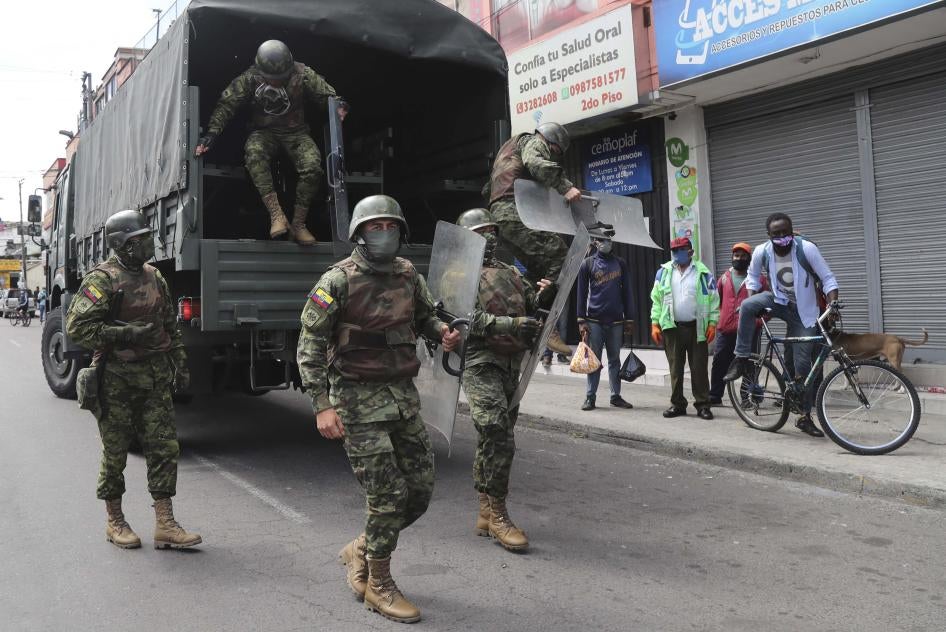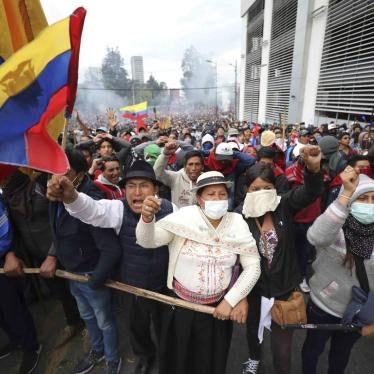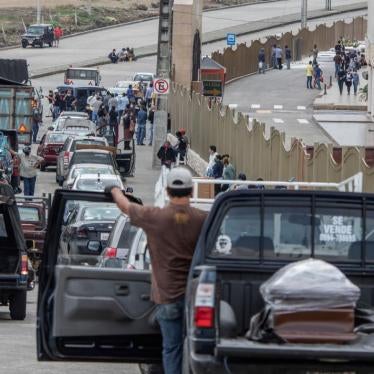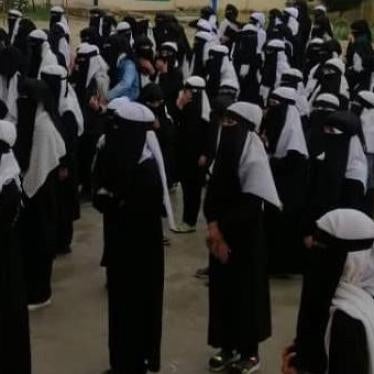(Washington, DC) – A ministerial resolution in Ecuador to regulate participation of the armed forces in law enforcement operations could encourage the use of lethal force in circumstances that go beyond what international human rights standards allow, Human Rights Watch said today
The Defense Ministry adopted the resolution on May 29, 2020. It provides that military operations should observe the principles of legality, necessity, and proportionality established under international human rights standards. But it simultaneously undermines those principles by giving the military broad powers to use lethal force and to participate in internal public security operations around demonstrations and meetings.
“Military forces are typically trained for war and not for law enforcement operations,” said José Miguel Vivanco, Americas director at Human Rights Watch. “Granting them powers, that go beyond what international standards allow, to use lethal force during demonstrations opens the door to serious abuses.”
Giving overly broad powers to the military is particularly worrying at a time when different sectors of the public are protesting against the government over issues ranging from the handling of the bodies of people suspected of dying of Covid-19 to a budget cut for education and allegations of corruption, Human Rights Watch said.
On June 2, the Ombudsperson’s Office filed a complaint before the Constitutional Court alleging that the aforementioned resolution threatens “fundamental rights enshrined in the Constitution and international human rights instruments.”
Human Rights Watch reporting shows that Ecuadorean police and military forces have used excessive force against protesters and journalists during massive protests in October 2019, during which we also documented violence committed by protesters and that police beat and injured protesters in a Covid-19-related protest in May. Investigations into these allegations have not started yet or are still in preliminary stages.
The use of military forces for internal public order operations raises concerns for human rights given their lack of training in law enforcement. Moreover, it can be difficult to hold agents accountable for their actions when military authorities investigate abuses committed by their members.
In a case against Ecuador, the Inter-American Court of Human Rights held that states must be extremely careful “when they decide to use their armed forces as a means for controlling social protests, domestic disturbances, internal violence, public emergencies, and common crime.” The court ruled that there must be “a clear demarcation between military and police duties.”
The Ministry of Defense resolution fails to make this distinction and instead broadly authorizes military use of force in “meetings, demonstrations, internal disturbances and other situations of internal violence that lead to serious internal commotion or public calamity.” The resolution does provide that use of force in these cases requires a prior declaration of a state of exception, but that can be decreed in a range of circumstances. Indeed, the government declared a state of emergency to deal with the Covid-19 pandemic on March 15, 2020. At the conclusion of the maximum term of 90 days established in the Constitution for states of emergency, the government decreed another one, for 60 days, on June 15.
The resolution also authorizes the use of force by the armed forces “in operations supporting other state institutions,” including the police, even without a state of emergency.
The resolution establishes a scale with five levels of force that military personnel may use, depending on “the resistance of the aggressor.” However, the resolution also categorizes several actions as “imminent lethal threats” to state agents in ways that are inconsistent with international standards. For example, if a person carrying a firearm or a replica refuses to drop it, after receiving just one warning, the resolution authorizes the agent to use “firearms with lethal munition.” International standards do not automatically authorize this kind of escalation in the use of force.
Under the United Nations Basic Principles on the Use of Force and Firearms by Law Enforcement Officials, security officers can only employ firearms when “less extreme means,” including violent ones, are insufficient. This principle is important as it recognizes that firearms are more likely to cause death or injury than other uses of force. For that reason, the legal criteria for security forces to use firearms, in exceptional circumstances, is not that non-violent means are ineffective, but that other less lethal modes of force are impracticable. In compliance with the UN principles, firearms cannot be used except for self-defense or defense of others. Even in those cases, security agents may not shoot to kill unless it is “strictly unavoidable in order to protect life.”
“The Ecuadorean government should urgently modify the resolution on armed forces’ involvement in law enforcement activities and ensure that its guidelines on the use of lethal force strictly comply with international human rights legal obligations and are effective in preventing, not encouraging, military abuses,” Vivanco said.








